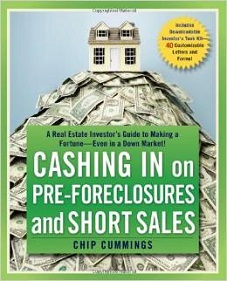Cashing In on Pre-foreclosures and Short Sales
 Cashing In on Pre-Foreclosures and Short Sales - How Smart Investors Turn Distress Into Opportunity
Cashing In on Pre-Foreclosures and Short Sales - How Smart Investors Turn Distress Into OpportunityFlipping houses is hot—but flipping distressed properties? That’s where the real profit potential lies. Cashing in on pre-foreclosures and short sales is a powerful strategy for real estate investors willing to do the homework, show up with solutions, and negotiate win-win deals. These properties often fly under the radar of the average buyer, but to a prepared investor, they’re goldmines just waiting to be polished.
The catch? You need to know how to find them, work the system, and move quickly—without getting caught in red tape or emotional burnout. Here’s how to do exactly that.
Why Pre-Foreclosures and Short Sales Matter
Let’s start with the basics. A pre-foreclosure is a property in default but not yet seized by the bank. The owner is behind on payments and facing foreclosure—often anxious, overwhelmed, and open to offers. A short sale happens when a lender agrees to accept less than what's owed on the mortgage, allowing the property to be sold before it hits foreclosure.
These situations can be emotionally charged, but they also present unique opportunities:
-
Motivated sellers are often eager to avoid foreclosure and save their credit.
-
Banks want out—fast. They’d rather take a partial loss now than deal with the hassle of repossession.
- You get access to discounts, flexibility, and creative deal structures not available in traditional listings.
But opportunity doesn’t guarantee success. You need a system.
Spotting Opportunities Early
Success starts with sourcing. Most counties publish Notice of Default filings - those are your leads. You can also use tools like PropStream, Zillow’s pre-foreclosure filter, or even local newspapers.
Here’s what to look for:
-
Homes with long DOM (Days on Market) and price drops
-
Listings with keywords like "subject to bank approval" or "third-party review required"
- Unkempt yards in decent neighborhoods (especially if taxes are behind)
Don’t wait until everyone’s chasing the same property. Make pre-foreclosure lead generation a daily habit. If you're not sure how, download the Fix and Flip Field Guide - its free and includes ten smart sourcing strategies to put you ahead of the competition.
Make It About Solving, Not Selling
When approaching a pre-foreclosure seller, you’re not just making an offer—you’re offering an exit. That means empathy, education, and options.
Lead with:
-
A willingness to listen first - what do they need?
- Solutions like cash offers, leasebacks, or subject-to deals
- Guidance on the short sale process if they’re underwater
Remember: the seller is likely in distress. Don’t come across as a vulture. Be the lifeline, and you'll stand out from every other "we buy houses" pitch they’ve heard.
Navigating the Short Sale Process
Cashing in on pre-foreclosures and short sales means playing the long game. Short sales can take time—sometimes months—so patience and persistence are critical.
What to expect:
-
You’ll need to submit a short sale package to the lender, often including a hardship letter from the seller, proof of funds, and your offer.
-
You may face delays as the lender reviews comps and loss projections.
- Flexibility is key—never over-rehab or overpromise timelines until the deal closes.
Pro tip: Always have a backup property in the pipeline. Treat short sales as a numbers game. The more educated offers you make, the more likely you’ll score a win.
Flip With Strategy, Not Emotion
Let’s be honest—flipping isn’t for the faint of heart. There’s risk, regulation, and renovation all wrapped into one. But here’s the thing: when you buy distressed, you start with built-in equity. That’s your cushion.
Here’s how to maximize your flips:
-
Stick to cosmetic upgrades with high visual ROI—paint, floors, landscaping
-
Avoid structural rehabs unless you’ve got deep experience or trusted contractors
- Know your comps, hold times, and resale timeline before making the offer
This isn’t HGTV—it’s business. Every dollar you spend should either increase resale value or reduce time on market.
Cashing In Without Burning Out
So, what’s the bottom line? Cashing in on pre-foreclosures and short sales is about combining speed with strategy. You need to be visible to sellers early, offer real solutions, and understand the legal dance of distressed deals. Done right, it’s not just a niche—it’s a sustainable, scalable pathway to serious income.
But trying to figure it all out solo is a recipe for burnout. That’s why tools and training matter.
If you want a smart head start, download the Fix and Flip Field Guide—a bonus resource packed with:
- Ten high-ROI strategies every house flipper should know
- Checklists for sourcing, evaluating, and flipping distressed properties
- Insider tips to keep your deals compliant, profitable, and on track
📥 Click here to download the Fix and Flip Field Guide and sharpen your investment approach.
Final Thoughts
Distressed properties are like diamonds in the rough—most walk past them, but smart investors polish them into profits. If you’re serious about flipping and ready to go beyond the basics, cashing in on pre-foreclosures and short sales can be your edge in a competitive market.

📘 Want to go deeper?
Grab your copy of Cashing In on Pre-Foreclosures and Short Sales by Chip Cummings—an essential guide that unpacks the legal, financial, and practical details behind profitable distressed-property deals.
Home Page > Real Estate Articles >> Flipping Real Estate >> Cashing In on Pre-foreclosures and Short Sales by Chip Cummings

